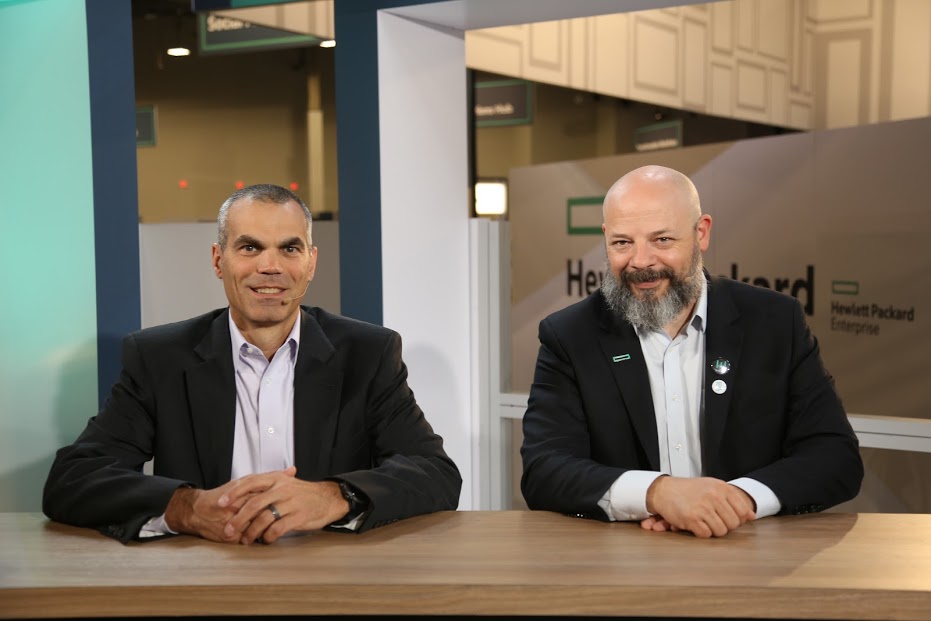 CLOUD
CLOUD
 CLOUD
CLOUD
 CLOUD
CLOUD
Necessity is the mother of invention, and what the technology industry needs right now is the capability to handle and manage the proliferation of data, along with the complexity of the Internet of Things. Hewlett Packard Enterprise Co. launched The Machine last November, promising a new architecture that provides limitless memory at the core of the system and distributes mesh computing to optimize the data created by devices. Does The Machine deliver?
Andrew Wheeler (pictured left), fellow, vice president and deputy director, HP Labs, at HPE, explained the need for the marketing hype at the last HPE Discover was an effort to engage the ecosystem and to get the community on board and begin contributing.
“Now we have been heads down, especially this last six months getting it all together. Think about what we showed [when we] first booted the thing in November. And now you know we’ve got it running at this scale, that’s really been the focus.” Wheeler said.
Wheeler and Kirk Bresniker (pictured right), fellow, vice president and chief architect, HP Labs, at HPE, spoke with John Furrier (@furrier) and Dave Vellante (@dvellante), co-hosts of theCUBE, SiliconANGLE’s mobile live-streaming studio, during the HPE Discover event in Las Vegas. (* Disclosure below.)
This week theCUBE features Andrew Wheeler and Kirk Bresniker as its Guests of the Week.
Behind the scenes, HP Labs is looking to fuel innovation through in-house research and development. HP Labs is over 50 years old and is responsible for some major contributions to technology throughout its long history. Today, HP Labs’ role within HPE is to disrupt business as usual, looking for new opportunities and finding the right blend.
The HP Lab has an “innovation horizon” that searches for opportunities in the short-term (1 to 3 years out) and an advanced development period that allows technology more time to incubate (3 to 5 years out). And then there is pure research, which presents HP Labs with high- risk, high-reward advantages, according to Wheeler.
Connecting to the edge has its restrictions. Memory-driven computers, like HPE’s The Machine, offer a new architecture that provides limitless memory at the core of the system and distributes mesh computing to optimize the data created by devices.
However, to make this happen the communication between the core and the edge must have standards, and data making the return trip has to be in a form where it is immediately actionable. Moreover, adding legacy data to new data and getting real-time results is a challenge with in-memory processing. Bresniker acknowledged that this is a longer-term goal. He sees the “edge,” where these devices live, as being transformative. While there are some security problems now, he believes they will work out over time, mainly because the possibility of economic transformation will necessitate it.
“Right now almost all that data on the edge is thrown away. If you are the first person who understands, ‘I’m going to get 1 percent more of that data and turn it into real-time intelligence, real-time action’ … that will unmake industries, and it will remake new industries,” Bresniker said.
Future commercial development, however, is not too far away, and Bresniker feels there is a broad palette for opportunity. He sees the technology going into existing rack and tower products that provide composable memory down to the individual module level with the capability of being able to take that facility and apply the right resources at just the right time, with a single-view API that extends down to composing the hardware itself.
“I think we look at those Edgeline Systems and want to have just the right kind of analytic capability, large persistent memories at that edge. We can handle those zettabytes of data in full-fidelity, analyzed at the edge, sending back that intelligence to the core but also taking action at the edge in a time-frame that matters,” he explained.
Some of the research and development HP Labs is doing will drive all of this technology into the existing, conventional enterprise market, as well as the intelligent edge, Wheeler and Bresniker stated.
During the interview, the pair also discussed topics ranging from the latest in security to how they recruit data scientists.
Watch the complete video interview below, and be sure to check out more of SiliconANGLE’s and theCUBE’s independent editorial coverage of HPE Discover US 2017. (* Disclosure: TheCUBE is a paid media partner for HPE Discover US 2017. Neither Hewlett Packard Enterprise Co. nor other sponsors have editorial control on theCUBE or SiliconANGLE.)
Support our mission to keep content open and free by engaging with theCUBE community. Join theCUBE’s Alumni Trust Network, where technology leaders connect, share intelligence and create opportunities.
Founded by tech visionaries John Furrier and Dave Vellante, SiliconANGLE Media has built a dynamic ecosystem of industry-leading digital media brands that reach 15+ million elite tech professionals. Our new proprietary theCUBE AI Video Cloud is breaking ground in audience interaction, leveraging theCUBEai.com neural network to help technology companies make data-driven decisions and stay at the forefront of industry conversations.